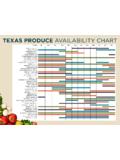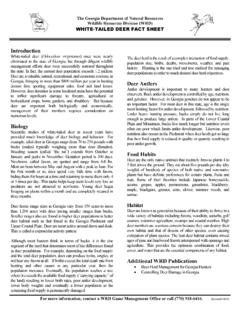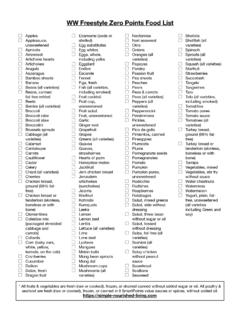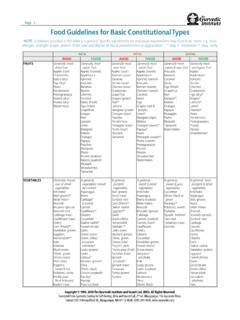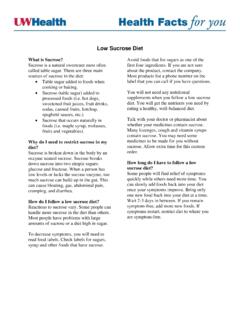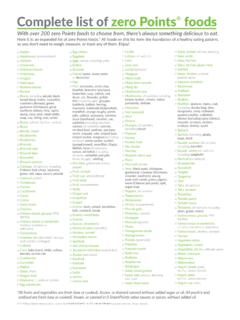Transcription of COMPATIBILITY, TEMPERATURE GUIDELINES & ETHYLENE …
1 Know Your Commodity COMPATIBILITY, TEMPERATURE GUIDELINES &. ETHYLENE SENSITIVITY. COMPATIBILITY, TEMPERATURE GUIDELINES . Source: United States Department of Agriculture (USDA). Load Compatibility Groups1. Group 1 Group 3. 2. Apples Grapes (see groups 2 and 6a) Cantaloupes Apricots Peaches Cranberries Berries (except cranberries) Pears Lemons (adjust TEMPERATURE to other commodity). Cherries Persimmons Lychees (also see group 4). Figs (not with apples, danger of Plums and prunes Oranges odor transfer to figs; also see group Pomegranates Tangerines 6a) Quinces Recommended Transit Conditions: Recommended Transit Conditions: TEMPERATURE : TEMPERATURE : 36 to 41 F ( to C).
2 32 to 34 F (0 to C). Relative humidity: Relative humidity: 90 to 95 percent; cantaloupes about 95 percent 90 to 95 percent Ice: Atmosphere: In contact only with cantaloupes Normally used on berries and cherries only 10 to 20 percent CO2 Group 4. Ice: Beans, snap Never in contact with commodity. Lychees (also see group 3). Okra Note: Most members of this group are not compatible with group 6a or 6b because ETHYLENE production by group 1 can be high, and thus harmful to Peppers, green (not with beans). members of group 6a or 6b. Peppers, red (if with green peppers, TEMPERATURE adjusted toward top of range).
3 Squash, summer 1. Taken from USDA Marketing Research Report No. 1070, Compatibility of Fruits and Vegetables Tomatoes, pink (also see group 2). During Transport in Mixed Loads, by Lipton and Harvey, 1977. Watermelons (also see groups 2 and 5). 2. Grapes: Compatible with other commodities only if the grapes are not fumigated with sulfur dioxide (SO2) in vehicle and if no chemicals that release SO2 are included in packages. Recommended Transit Conditions: TEMPERATURE : 40 to 45 F ( to C). Group 2. Relative humidity: Avocados Honey Dew About 95 percent Bananas Persian Eggplants (also see group 5) Olives, fresh Ice: Grapefruit3 Papayas Never in contact with commodity Guava Pineapples (not with avocados, Limes danger of avocados odor Group 5.)
4 Mangoes absorption). Cucumbers Muskmelons, other than Tomatoes, green Eggplants (also see group 2). cantaloupes Tomatoes, pink (also see group 4). Ginger (not with eggplants, also see group 7). Casaba Watermelons (also see groups 4 and 5). Grapefruit, Florida (after January 1), and Texas Crenshaw Potatoes (late crop). Pumpkin and squashes, winter Recommended Transit Conditions: Watermelons ( TEMPERATURE adjusted for other members of groups;. TEMPERATURE : also see groups 2 and 4). 55 to 65 F (13 to 18 C). Relative humidity: Recommended Transit Conditions: 85 to 95 percent TEMPERATURE : 40 to 55 F ( to 13 C); ginger not below 55 F.
5 Ice: Never in contact with commodity Relative humidity: 85 to 90 percent 3. Citrus Fruits : Oranges and tangerines compatibility depends on source. Florida or Texas grown oranges are shipped at 32 to 34 F ( to C), but oranges grown in California and Arizona are Ice: shipped at 38 to 48 F ( to C). Never in contact with commodity Know Your Commodity Page 1 of 3. Published by Blue Book Services Know Your Commodity COMPATIBILITY, TEMPERATURE GUIDELINES . Source: United States Department of Agriculture (USDA). Group 6a Group 7. Artichokes Mushrooms Ginger (also see group 5).
6 Asparagus Parsley Potatoes, early crop (temperatures adjusted for others). Beets, red Parsnips Sweet potatoes Carrots Peas Endive and escarole Rhubarb Recommended Transit Conditions: Figs (also see group 1) Salsify TEMPERATURE : Grapes (also see group 1) Spinach 55 to 65 F (13 to 18 C). Greens Sweet corn Relative humidity: Leeks (not with figs or grapes) Watercress 85 to 90 percent Lettuce Ice: Never in contact with commodity This group, except for figs, grapes, and mushrooms, is compatible with group 6b. Recommended Transit Conditions: TEMPERATURE : Group 8.
7 32 to 34 F (0 to C) Garlic Relative humidity: Onions, dry 95 to 100 percent Recommended Transit Conditions: Ice: TEMPERATURE : Never in contact with asparagus, figs, 32 to 34 F (0 to C). grapes, or mushrooms Relative humidity: 65 to 75 percent Group 6b Ice: Broccoli Never in contact with commodity Brussels sprouts Cabbage Cauliflower Celeriac Horseradish Kohlrabi Onions, green (not with rhubarb, figs, grapes, mushrooms, or sweet corn). Radishes Rutabagas Turnips This group is compatible with group 6a, except for figs, grapes, and mushrooms. Recommended Transit Conditions: TEMPERATURE : 32 to 34 F (0 to C).
8 Relative humidity: 95 to 100 percent Ice: Contact acceptable for all Know Your Commodity Page 2 of 3. Published by Blue Book Services Know Your Commodity ETHYLENE SENSITIVITY. Compatibility Chart for Fruits & Vegetables Source: University of California Davis Compatible produce for long distance transport. Produce in the same TEMPERATURE section can be mixed safely. ETHYLENE -sensitive vegetables should not be mixed with ETHYLENE -producing fruits and vegetables. Dry vegetables can be mixed with other fruits and vegetables on trips lasting less than about one week.
9 ETHYLENE -sensitive vegetables Not sensitive to ETHYLENE vegetables (32-36 F) (32-36 F). arugula herbs alfalfa sprouts mint asparagus leek8 amaranth mushroom7. Belgian/endive lettuce anise parsnip broccoli mustard greens artichoke radicchio Brussels sprouts parsley beans: fava, lima radish cabbage1 snow peas bean sprouts rhubarb7. carrot1,3 spinach beet rutbaga cauliflower sweet peas bok choy shallot celery1,3,9 turnip greens garlic sweet corn7. collard watercress horseradish water chestnut escarole kale green onion9. (45-50 F). (45-50 F). basil beans: green, snap10.
10 Chayote cucumber cowpea pepper: bell, chili10. eggplant5 okra tomatillo squash, summer (55-65 F). squash: pumpkin, sweet potato winter, yam Not sensitive to ETHYLENE fruits Not sensitive to ETHYLENE vegetables (55-65 F). (45-50 F). dry onion9 ginger5 avocado (unripe) orange4,9. jicama melon: bitter cactus pear1,9 passion fruit potato tomato cranberry pineapple2,10. guava tamarillo ETHYLENE -producing (very low) fruits and kumquat tamarind melons (32-36 F) mandarin4,9 tangelo4,9. olive watermelon apple1,3,9 grape6,7,8. apricot loquat (55-65 F).
